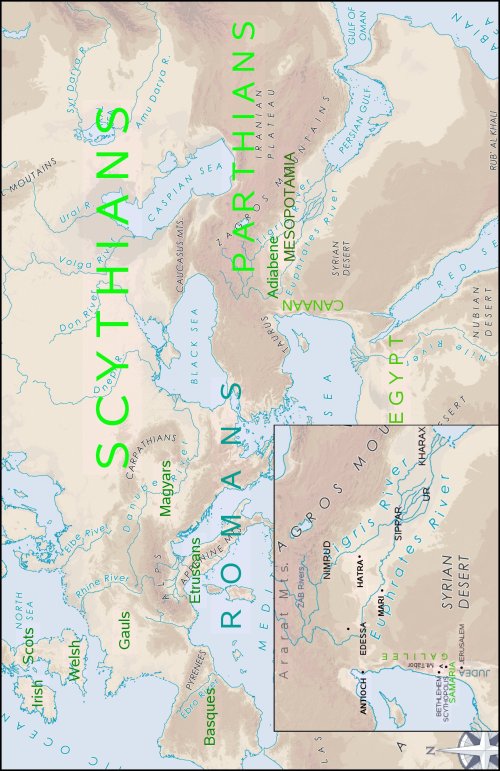Condensed timeline of some major events in the early history of the people of the Light
9000 BC - Early Neolithic Magyars are established in today's Hungary, and expand as the ice retreats. They become also known as Caucasians, Huns and Scythians. By the 8th mil. BC, they are an agricultural society. They pray to their Heavenly Mother in Tatárlaka, Hungary in 5500 BC, and build churches in her honor (6th mil. BC). They spread east toward India, China and beyond, south to North Africa as far as the Cataracts of the Nile, and west to the shores of the Mediterranean and to Western Europe where they become known as Celts, bringing their civilization: beliefs, laws, knowledge and written language. Scythians of the Near East emerge after the Flood, and build canals to drain the marshes of Mesopotamia where they settle. The Neolithic revolution in the Fertile Crescent results in a demographic and economic growth that lays the foundations of the “Sumerian” civilization. Their culture also reaches the Americas where it is known as the Maya civilization.
2500 BC - First appearance of nomadic Semitic tribes in Mesopotamia. The Sumerian civilization exerts a dominant influence upon the development of early Semitic cultures. Ancient Semites worship the Queen of Heaven.
2300 BC - The Semite Sargon imposes his hegemony on parts of Sumer. Mesopotamia is devastated by wars; the population is decimated. Semite immigrants of Mesopotamia conceive and worship their new god, Ea.
2000 BC - Sumerians and their allies overthrow the Hebrew so-called Agade hegemony, liberating themselves from foreign oppression. Gudea teaches neighborly love, and calls bread “Body of God.”
1700 BC - Hebrew Babylonians impose their hegemony on parts of Mesopotamia and introduce such alien concepts as land ownership and righteous cruelty. Sumerians rule over Southern Mesopotamia from 1860 to 1492 BC.
1100 BC - The Kassite-Scythians of today's Western Iran overthrow the Hebrew Babylonian hegemony and establish their rule over Northern Mesopotamia.
700 BC - Hebrew Assyrians impose their hegemony over the Near East after centuries of warfare. The ensuing devastation, decimation, deportations and oppression alter the ethnic composition of the Near East as the Semitic element increases and the non-Semitic people dwindle.
600 BC - Mede and Chaldean-Scythians annihilate the Assyrian Empire. Later, a political power known as the Persians conquers Mesopotamia and much of the Near East. Mede and Chaldean magi teach the early Greek thinkers (Pythagoras, Socrates, Plato, Aristotle, and others).
256 BC - The Parthian Empire, a political alliance of non-Semitic peoples regains control of the land between Palestine and India, and stops the eastward expansion of the later Roman Empire.
200 BC - The Hun Empire reaches its greatest extent, from Siberia to Parthia, the Baltic, the Roman Republic, to Gaul.
53 BC - The Parthians retake much of Canaan (Palestine). Herod flees to Rome but later recaptures Judea.
6 BC - Jesus is born in Bethlehem, Galilee. Magi travel from Sippar, Mesopotamia to greet the “Son of Light.”
27 - Jesus teaches neighborly love and the Truth. He is tortured and killed by the Jews but resurrects. Rabbi Saul purges Jesus' followers.
226 - The Sassanids overthrow the Parthian Empire (The Parthians briefly regain power—272-326). The defeated Parthian-Scythians begin a migration north to their kin, the Huns of the Carpathian Basin and the Caucasus.
5th c. - The Huns repell the Moors, defeat the Goths and the Romans, and Atilla imposes taxes on the Romans, setting in motion the collapse of the Western Roman Empire. Jews begin their migration east to Byzantine, and west to Western Europe. Scythians of Parthia continue to migrate north to the Carpathian Basin. Byzantine's attempt to convert the Huns to Judeo-Christianity fails after the Huns rebel against the Judeo-Christian missionaries' destruction of the Huns' religious symbols.
6-20th c. - Reinforced by waves of their kindred, refugees from Mesopotamia, join the Magyar-Hun confederacy in the Carpathian Basin the West calls the “Avars.” The Holy Roman Empire is born in Western Europe. Jews migrate with the Holy Roman Empire and, along with Sephardic Jews ousted from Spain, appropriate the Ashkenaz(im) name. They spread to all of Europe, including Hungary. The Magyar nations east of the Carpathians under the leadership of Árpád reinforce the Magyars (Hun, Székely, “Avar”) of the Carpathian Basin and launch a series of military campaigns in Europe to recover their religious treasures pillaged by marauding Germanic tribes, and to foil German plans to invade Hungary. The rightful heir to the Árpád dynasty is killed following a conspiracy with the Holy Roman Empire. A succession of Hungarian kings and their heirs die young under mysterious circumstances. Hungarians are forced to convert to Judeo-Christianity during a 400-year purge of the Magus Faith. The Inquisition tortures and executes the magi and destroys their writings. A foreign feudal class rules their land. Hungary is truncated to 1/3 its size in 1920.
2008 - Hungary, last custodian of the Jesus Faith is being overrun by a massive influx of Jews sponsored by a puppet government—installed by a Tel Aviv-based agency and kept in power by riot police—while Magyars of the Carpathian Basin are denied Hungarian citizenship. And yet she lives on... in testimony of the Light
* * *

This study is also available as a PDF file HERE

